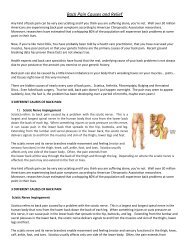Cellulite Causes, Prevention and Treatment
http://www.lnk123.com/aff_c?offer_id=118&aff_id=357950 Cellulite: Causes, Prevention and Treatment
http://www.lnk123.com/aff_c?offer_id=118&aff_id=357950
Cellulite: Causes, Prevention and Treatment
Create successful ePaper yourself
Turn your PDF publications into a flip-book with our unique Google optimized e-Paper software.
<strong>Cellulite</strong>: <strong>Causes</strong>, <strong>Prevention</strong> <strong>and</strong> <strong>Treatment</strong><br />
What is <strong>Cellulite</strong>?<br />
A great many people have cellulite - some sources say that it occurs in 90 percent of women. That's a lot of lumps! What<br />
is cellulite, anyway? Does it mean you're unhealthy? Can you get it if you're not overweight?<br />
<strong>Cellulite</strong> was not always considered unattractive. In days past, lumpy skin on the buttocks <strong>and</strong> thighs was considered<br />
feminine <strong>and</strong> was depicted favorably in paintings. But today, most of us consider cellulite unsightly <strong>and</strong> want to get rid<br />
of it. Regardless of how it's viewed, many of us are not sure just what cellulite is.<br />
Directly under the skin, there is a fat layer, particularly in women. This subcutaneous fat<br />
layer can become pitted <strong>and</strong> bumpy in appearance. Why it does so is subject to debate. But<br />
the fact that this fat layer is more predominant in women than in men has a lot to do with<br />
why women are more subject to cellulite.<br />
What <strong>Causes</strong> the Bumps?<br />
The jury is still out on this one. Nearly all sources agree that the lumps occur in the subcutaneous fat layer, but opinions<br />
differ as to how they get there.<br />
* Hormones may play a role, which would also help explain women's tendency to develop cellulite. In this day <strong>and</strong> age of<br />
synthetic hormones <strong>and</strong> chemical hormone disruptors (such as some pesticides), it's no wonder that hormonal<br />
imbalances are becoming more prominent. Hormones influence all sorts of body systems, including how the body stores<br />
fat.<br />
* Poor circulation is another possible cause of cellulite. When the circulation in a certain body area is poor, it may result<br />
in poor skin tone, "stagnant" fat cells <strong>and</strong> inadequate lymphatic drainage. These factors may come together to form the<br />
bumpy appearance of cellulite.<br />
* Heredity may also play a role. Your genes determine your skin thickness <strong>and</strong> overall body structure, which conspire to<br />
make you more or less vulnerable to cellulite.<br />
* A tight tissue "network" under the skin may also contribute to cellulite. The shape, placement, <strong>and</strong> flexibility (or lack of<br />
it) in the subcutaneous tissue plays a significant role in how lumpy the fat under the skin looks.<br />
Is It Unhealthy?<br />
<strong>Cellulite</strong> is not considered unhealthy per se. But it may be a sign of poor health if it results from excess body weight,<br />
poor exercise habits, or a build-up of toxins.<br />
Is <strong>Cellulite</strong> Just Fat?<br />
While cellulite is subcutaneous fat that appears lumpy, it's not "just fat." In fact, healthy subcutaneous fat can give you a<br />
youthful, smooth appearance, especially in the face. Some people will even have fat injected under the skin in a<br />
cosmetic procedure to "plump" certain areas of the body! So cellulite is not just fat; it's a particular manifestation of<br />
body fat. Not all body fat looks lumpy.<br />
What <strong>Causes</strong> <strong>Cellulite</strong>, <strong>and</strong> How Can You Get Rid of It?<br />
When you look in the mirror, there may be certain areas of your body that just don't look smooth, or that look dimpled<br />
<strong>and</strong> bumpy. Some say it looks like the skin of an orange, or like cottage cheese. You may know this is cellulite, but how<br />
did it get there? What is it, exactly? It is any different from regular fat?
<strong>Causes</strong> of <strong>Cellulite</strong><br />
Some people have cellulite from the time they are very young; others develop it when they are older. It is not just body<br />
fat. <strong>Cellulite</strong> is body fat, but it is a particular manifestation of it. While there is no one cause that can be pinpointed in all<br />
cases of cellulite, here are some of the commonly known causes of cellulite.<br />
* Heredity - Unfortunately, your genes may have much to do with how much cellulite you have. This may be particularly<br />
true for those who develop cellulite at a young age. It seems that in some families the tendency toward cellulite, like<br />
other bodily traits, may be passed from parent to child. This does not mean you can't do anything about it, though.<br />
* Age - Some sources note the "sagging" of fat cells as the way that cellulite forms, <strong>and</strong> as we age we become more<br />
prone to this weakening of fat cells. Fat under the surface of the skin is said to look smooth as long as the elastic nature<br />
of the fat cells remains intact. Aging may cause these fat cells to become less flexible <strong>and</strong> weaker, so that the dimples<br />
<strong>and</strong> pits of cellulite appear.<br />
* Poor diet - You may be thinking that for a "poor diet" to cause cellulite, it must be high in fat <strong>and</strong> unhealthy foods. This<br />
is only partially the case, however - many sources note that a diet low in healthy fat may contribute to cellulite<br />
formation. This is because the consumption of healthy fats helps build strong, healthy cells in your body. These good<br />
fats, or essential fatty acids (EFAs) may help the weak fat layer under your skin to become strong <strong>and</strong> flexible again.<br />
Toxins are said to sabotage the suppleness of the skin <strong>and</strong> fat layer, causing pits <strong>and</strong> bumps that hold these toxins.<br />
Depending on which school of thought you adopt, you could consider cellulite a sign that something is amiss with your<br />
health, whether it's circulatory health, poor diet, or hormone imbalances.<br />
How To Prevent <strong>Cellulite</strong>?<br />
It's said that taking preventative measures before cellulite has a chance to form can help prevent its formation. Even if<br />
cellulite is already a fact of life for you, prevention tips can help stop more cellulite from forming <strong>and</strong> may even reduce<br />
the appearance of existing cellulite. Here are some suggestions <strong>and</strong> ideas.<br />
Regular Exercise<br />
Exercise may help prevent <strong>and</strong> reduce cellulite, too. Regular exercise like walking or<br />
cycling is good to incorporate into your routine, <strong>and</strong> if you want to get serious about<br />
cellulite-prone areas, target-toning may help a lot toward prevention <strong>and</strong> reduction.<br />
Some sources say weight training is a good remedy for cellulite.<br />
Don't Smoke<br />
Because smoking fills your body with toxins, <strong>and</strong> a build-up of toxins may promote<br />
cellulite. In fact, some sources say that cellulite is almost entirely due to toxin build-up.<br />
Smoking can also contribute to overall poor health, which can manifest as saggy skin <strong>and</strong> a tired appearance.<br />
Smoking also has a profound effect on the circulatory system, causing blood vessels to constrict <strong>and</strong> the heart to pump<br />
faster. It's been theorized that cellulite may be caused in part by poor circulation. So avoiding smoking may prevent<br />
cellulite by keeping the circulation from being adversely affected.<br />
Healthy Diet<br />
A low-fat diet may be an importance aspect of cellulite prevention, but only if the diet is low in unhealthy fats. Studies<br />
suggest that a diet rich in healthy fats (in moderation, of course) may help reduce cellulite <strong>and</strong> prevent its formation.<br />
Basically, healthy fats keep body fat healthy, <strong>and</strong> some body fat under the skin, especially in women, is perfectly normal<br />
<strong>and</strong> healthy. This fat layer may become saggy <strong>and</strong> pitted if the fat cells are being "fed" by unhealthy fats in the diet.<br />
Replacing the bad fats with moderate amounts of healthy fats may help keep this normal fat layer in top shape.
Massage<br />
Massage is considered an important treatment for cellulite, but some regular<br />
massage to prevent cellulite may be in order. You can make a simple massage part<br />
of your daily routine with a h<strong>and</strong>-held, home massager specifically for cellulite or<br />
enjoy an occasional professional massage.<br />
Creams <strong>and</strong> Scrubs<br />
Like massage, creams <strong>and</strong> scrubs can be used for prevention or reduction of cellulite. Their application can also be made<br />
a part of your daily routine; just apply them after showering <strong>and</strong>/or before bed.<br />
Diet <strong>and</strong> Exercise as <strong>Treatment</strong> for <strong>Cellulite</strong><br />
Are you looking to rid yourself of cellulite, or reduce its appearance? If so, you might be overwhelmed by the<br />
treatments available out there.<br />
One of the frustrating things about cellulite is that losing weight does not necessarily get rid<br />
of it. Even skinny people can have cellulite! Whether or not weight is an issue, though, cellulite's appearance may be<br />
reduced through diet <strong>and</strong> exercise.<br />
An Anti-<strong>Cellulite</strong> Diet<br />
Because cellulite cannot really be pinned down to a single cause, a healthy, anti-cellulite diet<br />
incorporates multiple factors. Here are some aspects of such a diet.<br />
* Antioxidants - <strong>Cellulite</strong> may be partly due to the accumulation of toxins in the body. To<br />
address this potential cause of cellulite, sources recommend a diet rich in antioxidant foods,<br />
such as berries, tomatoes <strong>and</strong> green tea.<br />
* EFAs - Essential fatty acids - EFAs - are important for overall health, but sources suggest<br />
that EFAs are an important component of cellulite reduction. It is said that EFAs help make<br />
the fat cells of the body stronger <strong>and</strong> more elastic, thus reducing the dimpled appearance of cellulite.<br />
* Fiber - Diets that are high in fiber may promote intestinal health. While this may not seem like what you want in<br />
cellulite reduction, it's actually very likely that healthy digestion can help cellulite. After all, toxins are said to play a part<br />
in the appearance of cellulite, <strong>and</strong> healthy digestion aids the body in getting rid of these toxins.<br />
* Protein - If you want to build <strong>and</strong> tone muscle in order to reduce cellulite, eating lean protein may help. Muscle is<br />
made up of protein, <strong>and</strong> high-protein foods help your body build muscle. Replacing fatty foods with lean protein foods is<br />
a healthy step toward reducing cellulite.<br />
Exercises<br />
Exercises like lunges <strong>and</strong> squats help to work the thighs <strong>and</strong> buttocks. There are quite a few exercises out there<br />
specifically for the buttocks <strong>and</strong> thighs, because these tend to be problem areas for so many people. Just about all of<br />
these target-toning exercises can help reduce cellulite. Swimming, jogging, walking, biking, <strong>and</strong> other cardio exercises<br />
are great for overall health <strong>and</strong> fitness. Ideally, an anti-cellulite exercise routine would involve 15-30 minutes of cardio<br />
<strong>and</strong> 15-30 minutes of target toning several times a week. Exercises to reduce cellulite can be done in your home via<br />
DVD, video, or online tutorials. Or, you can join a class or gym.
Diet<br />
It could be said that combining exercise (see above), with diet is the best combination for combating cellulite. Experts<br />
say that a diet high in unhealthy fats (fats that are solid at room temperature, trans fats, <strong>and</strong> so forth) can contribute to<br />
cellulite, but a diet rich in healthy fats (Omega 3s, Omega 6s, <strong>and</strong> other essential fatty acids) may actually help reduce<br />
cellulite <strong>and</strong> prevent its formation. Apparently, when you consume healthy fats, you contribute to the healthy<br />
appearance of the skin <strong>and</strong> the fat cells beneath it.<br />
Lean protein, whole grains (for fiber <strong>and</strong> key nutrients), <strong>and</strong> lots of plant-based foods is probably your best bet for an<br />
anti-cellulite diet. Just changing your diet is probably not going to make all you cellulite magically disappear. However, it<br />
may contribute significantly to an overall regimen to reduce cellulite.<br />
Massage<br />
Poor circulation may contribute to cellulite formation. As noted above, exercise is a good way to boost your<br />
cardiovascular system, <strong>and</strong> target toning can enhance circulation right where the cellulite is. Massage may have a similar<br />
effect, bringing blood to the affected area <strong>and</strong> enhancing skin tone.<br />
Because cellulite is said to be an issue of skin as well as the fat layer beneath, massage can address both of these areas.<br />
Many home cellulite massagers are available on the market - perhaps the least expensive is a h<strong>and</strong>-held device meant to<br />
be used in the shower on wet, soapy skin. There are also electrical massagers available, <strong>and</strong> even spa treatments with<br />
professional massage.<br />
Creams <strong>and</strong> Scrubs<br />
Whether you go with homemade creams <strong>and</strong> scrubs or commercial ones, such topical treatments are said to be most<br />
effective when combined with other approaches. Anti-cellulite scrubs can help enhance circulation, as can "wraps,"<br />
where you apply a cream to the area <strong>and</strong> wrap it in plastic wrap. Creams often contain caffeine which is said to tighten<br />
up the skin.<br />
Treat <strong>and</strong> Eliminate <strong>Cellulite</strong> For Firmer Thighs, Legs <strong>and</strong> Butt<br />
Clinically Proven. You’ll See Visible Effects in 28 Days<br />
Click Here to Blast Away <strong>Cellulite</strong> With Revitol Today












